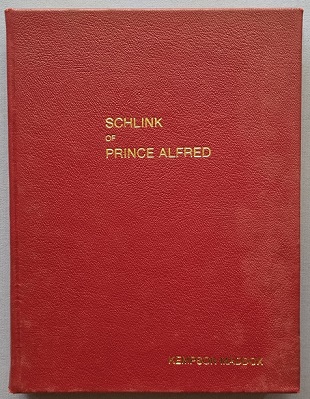Description
Title: Schlink of Prince Alfred
Editor: Maddox, Kempson
Condition: Very Good Plus – Signed by the author on the title page. Has some minor foxing on first and last few pages.
Edition: 1st Edition
Publication Date: 1978
ISBN: 0959817158
Cover: Hard Cover without Dust Jacket – 283 pages
Comments: This is a biography of Sir Herbert Schlink.
Sir Herbert Henry Schlink (1883-1962), gynaecologist and hospital administrator, was born on 28 March 1883 at Wodonga, Victoria, seventh child of German parents Albert Schlink, storekeeper and later vigneron, and his wife Maria Francesca, née Trudewind. He was educated at Wodonga State School, St Patrick’s College, Goulburn, New South Wales (dux 1900), and St John’s College, University of Sydney (M.B., Ch.M., 1907). In 1907 he was appointed junior resident medical officer at Royal Prince Alfred Hospital and in 1909 assistant superintendent. As medical superintendent in 1911, he remodelled the clinical school. Next year he was appointed honorary assistant gynaecological surgeon and began private practice in Macquarie Street, where he lived. Fair and ‘golden-haired’, Bertie became known for his taste in food and wine and his passion for Havana cigars; he dined frequently and played bridge at his clubs, the University and later the Australian.
Joining the Australian Army Medical Corps reserve in 1908, Schlink was gazetted captain and attached to the 40th (Western Suburbs, Sydney) Company, in August next year. In September 1914 he was appointed officer commanding that company, which in March 1915 took up duties at the Liverpool military camp. Following allegations in Federal parliament, Justice (Sir) George Rich, as royal commissioner, inquired into conditions at Liverpool and reported inter alia that ‘the impropriety and inexpediency’ of appointing an officer of German parentage was ‘so apparent as to call for no comment’. Despite Schlink’s declarations of loyalty he was immediately removed from the camp. Although remaining on the officers’ list until 1919, he felt he had suffered ‘political assassination’, especially as a brother was interned in Germany as an alien.
Although honorary gynaecological surgeon at Royal Prince Alfred from 1922 (and consultant from 1943), Schlink was not appointed a university lecturer until 1935 because of anti-German sentiment among non-medical members of the senate. He specialized in the treatment of pelvic cancer, initially with radical surgery, but later combining surgery with cobalt ray therapy. As a surgeon he was ‘fearless and aggressive, systematic and tireless’, and a founder of the (Royal) Australasian College of Surgeons (1927). Using statistical methods he pioneered the systematic follow-up of cancer patients. He met leading gynaecologists in England and Europe in 1923 and attended the 1928 Boston congress of the American College of Surgeons. In 1939 he published a textbook, Gynaecology (revised 1949, 1955), and he wrote extensively on the diseases of women.
A director of the hospital board from 1926, Schlink as chairman (1934-62) supervised the opening of Gloucester House, King George V Memorial Hospital for Mothers and Babies, Queen Mary Nurses’ Home, the neurosurgical and psychiatric blocks, the (Sir Earle) Page Chest Pavilion and the hospital chapel. In 1936 he introduced the three-tiered system of private, intermediate and public ward accommodation in a major teaching hospital. He published The Hospital Problem of the Metropolitan and Suburban Area of Sydney (1940) and envisaged R.P.A.H. as The National Medical Centre for New South Wales (1946). His dream was not fulfilled, but ‘Schlinktown’ did become the State’s leading teaching hospital. He was foundation president in 1946 of the Australian Hospital Association and edited its journal, Australian Modern Hospital (1949-56). In 1951 he became an honorary member of the American Hospital Association and Australian representative to the International Hospital Federation.
From the 1930s Schlink suggested that hospital funds should be augmented by non-profit-making insurance schemes. He opposed the ‘socialization’ of medicine, notably the Labor government’s proposed national health scheme in 1948, but later advised (Sir) Robert Menzies and Page. He was a foundation council-member of the (Metropolitan) Hospital Contribution Fund (1932-62), the Medical Benefits Fund and the Blue Cross Association.
Schlink enjoyed annual skiing holidays from 1909 and in 1926 made the first winter crossing from Kiandra to Kosciusko. Foundation member and long-term president of the Kosciusko Alpine Club (1909-20) and its successor, the Ski Club of Australia (1921-62), he was a member of the Ski Club of Great Britain (1910-62) and an honorary member of the Kandahar Ski Club (Gold K) from 1928. In 1960 the Schlink Pass between Guthega and Geehi was named after him. Among his other activities he was a fellow of St John’s College (1928-62) and of the Ancient Monument Society, England (1958), and a member of Royal Sydney Golf Club. He was a fellow of the Royal Geographical Society, London (1929) and of the Royal College of Obstetricians and Gynaecologists, London (1951), and was knighted in 1954.
At St Mary’s Cathedral Schlink married Margaret Mulvey (b.1916), medical practitioner, on 28 June 1945. He enjoyed gardening and entertaining at his Careel Bay home. Widely read and interested in sculpture and opera, he was a brilliant conversationalist. Survived by his wife, he died childless on 30 November 1962 and was buried in the Catholic section of Mona Vale cemetery. Next week an ecumenical memorial service was held at the hospital chapel. Portraits of Schlink by Fred Leist are held by King George V and Royal Prince Alfred hospitals; a bust by Andor Meszaros is in the latter.




